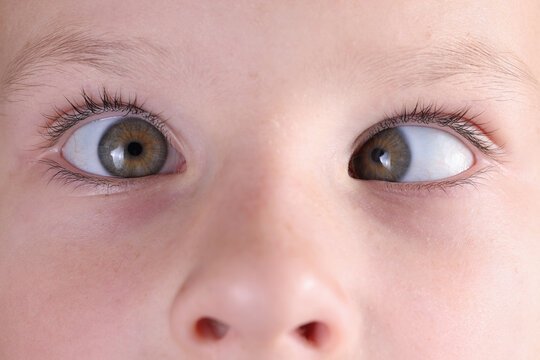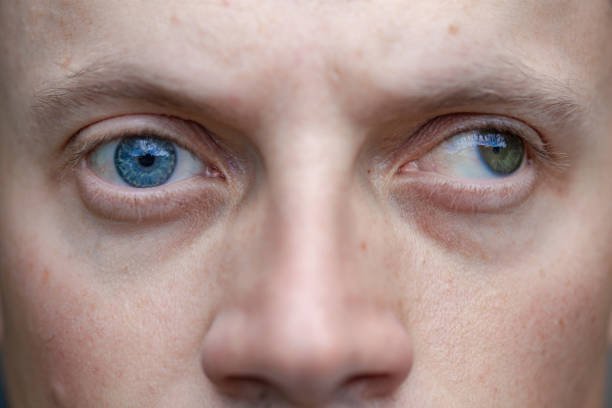Strabismus (Crossed Eyes): Causes, Types, Symptoms, and Treatments
Strabismus, known as crossed eyes, is a visual condition characterised by the misalignment of one or both eyes. This misalignment can manifest in various forms, leading to challenges in vision and depth perception. Strabismus can affect individuals of all ages, from infants to adults, and its causes are often multifaceted, ranging from genetic predispositions to neurological disorders.
This post will delve into the underlying factors contributing to strabismus, the different ways this condition can present itself, and the symptoms that may indicate its presence. We will also discuss how eye care professionals diagnose strabismus and the various treatment options available, including both non-surgical and surgical approaches, that can improve visual function and quality of life.
What Is Strabismus?
Strabismus is a condition in which one or both eyes are misaligned. It is also commonly referred to as "crossed eyes" or "squint." While the term "crossed eyes" is widely used, it is important to note that strabismus encompasses a broader range of misalignments beyond just the eyes turning inward.
This misalignment in the eyes caused by strabismus can occur in various directions: one eye may turn inward (towards the nose), outward (away from the nose), upward, or downward, while the other eye remains focused on a specific point. Regardless of the direction of the misalignment, strabismus can interfere with normal binocular vision, which is the ability of the eyes to work together to create a single, clear image.
When the eyes point not in the same direction, the brain may receive two different images, leading to double vision, eye strain, or, in children, the suppression of vision in one eye to avoid double vision, potentially resulting in amblyopia (lazy eye).
What Causes Strabismus?
Strabismus can arise from various factors that disrupt the coordination necessary for proper eye alignment. The primary causes include genetic, neurological, muscular, and trauma-related factors.
Congenital (Present at Birth)
Childhood strabismus is often related to genetic factors or neurological conditions that develop shortly after birth. Muscle imbalances can also be a contributing factor in early-onset strabismus.
Neurological Disorders
Neurological conditions affecting the brain's control over eye muscles can lead to strabismus. These types of disorders can interfere with the signals that coordinate eye movements, resulting in misalignment. These disorders include:
Cerebral Palsy
Hydrocephalus
Brain Tumors
Down Syndrome
Muscle Weakness or Imbalance
The extraocular muscles surrounding each eye are responsible for controlling eye movement. Its weakness or imbalance can lead to misalignment. This may result from developmental issues or conditions affecting muscle function.
Trauma
Head injuries or strokes can damage the nerves or brain regions responsible for coordinating eye movements, leading to acquired strabismus.
Head Injuries: These can occur at any age and may result in changes to muscle control.
Stroke: More prevalent in adults and can lead to sudden onset strabismus due to damage to brain areas involved in eye coordination.
Vision Impairment in One Eye (Sensory Strabismus)
If one eye has significantly poor vision—due to conditions like cataracts, refractive errors, or other eye diseases—the brain may favour the stronger eye. Over time, this can cause the weaker eye to drift out of alignment, resulting in sensory strabismus. This condition is more common in children but can also affect adults.
Is Strabismus Genetic or Acquired?
Strabismus can be both genetic and acquired. Family history plays a role in its development during childhood. However, acquired forms of strabismus can occur later in life due to neurological events, trauma, or other underlying health issues.
Types of Strabismus (Crossed Eyes)
Strabismus can present in various forms, each characterised by a different pattern of eye misalignment.
1. Esotropia
Esotropia is characterised by one or both eyes turning inward toward the nose. This condition is the most common form of strabismus in infants and can be present at birth or develop in early childhood. In some cases, esotropia may be intermittent, occurring only sometimes, while in others, it may be constant.
2. Exotropia
Exotropia occurs when one or both eyes turn outward away from the nose. This type of strabismus can also be intermittent or constant and may become more pronounced during periods of fatigue or distraction. Exotropia is often seen in children and can lead to difficulties with binocular vision and depth perception.
3. Hypertropia
Hypertropia is defined by one eye being positioned higher than the other. This vertical misalignment can result from muscle imbalances or neurological issues affecting eye movement control. Hypertropia can occur in both children and adults and may lead to double vision if not addressed.
4. Hypotropia
Hypotropia is the opposite of hypertropia, where one eye is positioned lower than the other. Like hypertropia, this condition can be caused by muscle imbalances or neurological risk factors and may result in visual discomfort or double vision. Hypotropia can affect individuals of any age.
5. Paralytic Strabismus
Paralytic strabismus occurs when there is a loss of muscle control due to nerve damage or neurological conditions, leading to misalignment of the eyes. This type is more frequent in adults, often resulting from strokes, head injuries, or neurological disorders that affect eye movement. Individuals with paralytic strabismus may experience significant visual challenges, including double vision.
Symptoms of Strabismus
The symptoms of strabismus can vary depending on the type and severity of the misalignment. Here are some common symptoms to watch for:
Eyes that don't align: The most obvious sign of strabismus is a misalignment of the eyes. One eye may turn in another direction while the other eye looks straight ahead.
Head tilting or squinting: Individuals with strabismus may tilt their heads or squint to try to align their eyes and improve their vision. These compensatory behaviours are often subconscious.
Double vision: Adults and older children with newly developed strabismus may experience double vision (diplopia), as the brain receives two different images.
Poor depth perception: Strabismus can interfere with the ability to perceive depth accurately, making it difficult to judge distances and navigate spatial relationships.
Symptoms may also vary depending on the age of the affected individual.
Babies:
Intermittent eye crossing is common in newborns up to a few months old, but constant misalignment should be evaluated.
May not show obvious signs of visual discomfort.
Children/Teenagers:
May complain of headaches or eye strain.
May have difficulty with reading or close-up tasks.
May exhibit clumsiness or difficulty with sports due to poor depth perception.
Adults:
Double vision is a common complaint.
Eye strain and headaches.
Difficulty with activities requiring good depth perception, such as driving.
How Strabismus Affects Vision and Quality of Life
Strabismus can have a significant impact on both vision and overall quality of life, affecting individuals of all ages in various ways.
In children, strabismus can interfere with normal visual development and may lead to lazy eye, a condition in which the brain suppresses vision in the misaligned eye, resulting in reduced visual acuity. Poor depth perception can also affect a child's ability to participate in sports and activities. Socially, children with noticeable strabismus may experience teasing or bullying, which can affect their self-esteem.
Adults with strabismus may experience double vision, eye strain, and headaches, which can impact their ability to work, drive, and perform other daily tasks. The loss of depth perception can also make it difficult to navigate the environment safely. Additionally, adults with strabismus may feel self-conscious about their appearance and experience social anxiety.
How Is Strabismus Diagnosed?
Diagnosing strabismus requires a comprehensive eye examination performed by an optometrist or ophthalmologist. These exams are designed to assess eye alignment, visual acuity, and overall eye health. Several tests are commonly used to detect strabismus:
| Test Name | Purpose | How It Works |
|---|---|---|
| Corneal Light Reflex Test | Assess eye alignment | The doctor shines a light on the patient's eyes and observes where the light reflects off the cornea. In properly aligned eyes, the light reflex will be in the same location in each eye. |
| Cover Test | Detect subtle misalignments | The doctor covers one of the patient's eyes and watches the other eye for movement. This test can reveal whether the uncovered eye needs to move to fixate on a target. The covered eye is then uncovered to observe any movement as it refocuses. |
| Visual Acuity Test | Measure sharpness of vision | The patient reads letters or symbols from a standardized eye chart to determine how well they can see at various distances. |
| Neurological Exams | Identify underlying neurological conditions | A neurological examination may be conducted to assess nerve function and rule out any neurological disorders that could be contributing to the strabismus. |
Treatment Options for Strabismus
The goal of strabismus treatment is to align the eyes, restore binocular vision (the ability of the eyes to work together), and improve overall visual function. Treatment options depend on the severity of strabismus and its type, as well as the age and overall health of the individual. Both non-surgical and surgical approaches are available:
Non-Surgical Treatments
Non-surgical treatments are typically the first line of defence for strabismus, particularly in children. These options aim to correct underlying vision problems, strengthen eye muscles, and improve eye alignment.
Glasses or Contact Lenses: Refractive errors, such as nearsightedness, farsightedness, or astigmatism, can contribute to strabismus. Corrective contact lenses can help to improve vision and, in some cases, reduce or eliminate eye misalignment.
Vision Therapy Exercises: Vision therapy involves exercises designed to strengthen eye muscles, improve eye coordination, and enhance visual skills. These are typically performed under the supervision of a trained vision therapist and can be particularly helpful for individuals with mild to moderate strabismus.
Botox Injections: Botulinum toxin (Botox) injections can be used to temporarily weaken overactive eye muscles, allowing the eyes to align more effectively. This treatment is typically used for certain types of strabismus, such as paralytic strabismus, and the effects usually last for several months.
Surgical Treatments for Strabismus
Eye muscle surgery is often recommended when non-surgical treatments are not sufficient to correct eye misalignment. During the procedure, the surgeon may either weaken or strengthen specific eye muscles by detaching them from the eye and reattaching them to a new position for better alignment. In some cases, strabismus surgery may involve both weakening and strengthening muscles in the same eye or in both eyes.
Can Strabismus Be Prevented?
While not all cases of strabismus are preventable, certain ways can help reduce the risk of developing the condition or to minimise its impact.
Regular Eye Exams for Children: Routine eye exams are crucial for detecting vision problems, including strabismus, in children. Early detection allows for timely intervention, which can help prevent amblyopia (lazy eye) and other vision problems associated with strabismus.
Managing Neurological Conditions Early: In some cases, managing neurological conditions effectively can help to reduce the risk of developing strabismus. This may involve medical treatment, physical therapy, or other interventions, depending on the specific neurological condition.
Eye Exercises for Muscle Strength: While eye exercises are not a guaranteed way to prevent strabismus, they may help to improve eye muscle strength and coordination. Vision therapy exercises, prescribed and supervised by a trained vision therapist, can be particularly beneficial for individuals at risk of developing strabismus or those with mild misalignment.
Is strabismus only a condition that affects children?
While strabismus is often diagnosed in childhood, it is not exclusively a childhood condition. Adults can also develop strabismus, even if they did not have it as children. Adult-onset strabismus may be caused by neurological conditions, trauma, or other underlying health issues.
Does it cause permanent vision loss?
Strabismus can lead to permanent vision loss, particularly in children, if left untreated. The most common complication of untreated strabismus is amblyopia, or "lazy eye,".
Strabismus vs Lazy Eye
While the terms "strabismus" and "lazy eye" are sometimes used interchangeably, they are distinct conditions that can be related.
| Feature | Strabismus (Crossed Eyes) | Lazy Eye (Amblyopia) |
|---|---|---|
| Definition | Misalignment of the eyes. | Reduced vision in one eye due to abnormal visual development. |
| Primary Issue | Lack of coordination between the eyes. | Brain favours one eye, suppressing the other. |
| Cause | Muscle imbalance, nerve damage, or other underlying health conditions. | Often caused by strabismus but can also result from other vision problems like significant refractive errors. |
| Effect | Double vision, eye strain, or suppression of vision in one eye. | Reduced visual acuity in one eye and poor depth perception. |
| Treatment | Corrective lenses, vision therapy, Botox injections, or eye muscle surgery. | Corrective lenses, patching the stronger eye to force the weaker eye to work, vision therapy. |
| Link | It can cause a lazy eye if the misalignment leads to the brain suppressing the image from one eye over time. | Often, it is a result of untreated strabismus in childhood, where the misaligned eye is not used properly. |
Conclusion
Strabismus, or crossed eyes, is a condition characterised by the misalignment of one or both eyes, impacting individuals of all ages. This misalignment can stem from various causes, including genetic predispositions, neurological disorders, muscle imbalances, and trauma.
Early recognition of symptoms, such as misaligned eyes, head tilting, double vision, and poor depth perception, is essential for timely intervention. Strabismus can significantly affect both vision and quality of life, potentially leading to amblyopia in children and visual discomfort in adults.
Treatment options range from non-surgical approaches, including glasses, vision therapy, and Botox injections, to surgical interventions aimed at realigning the eye muscles. While not all cases of strabismus are preventable, regular eye exams, early management of neurological conditions, and eye exercises can help reduce the risk and impact of this condition.
If you suspect that you or your child may have strabismus, consulting with an eye care professional is crucial for comprehensive evaluation and personalised care.







